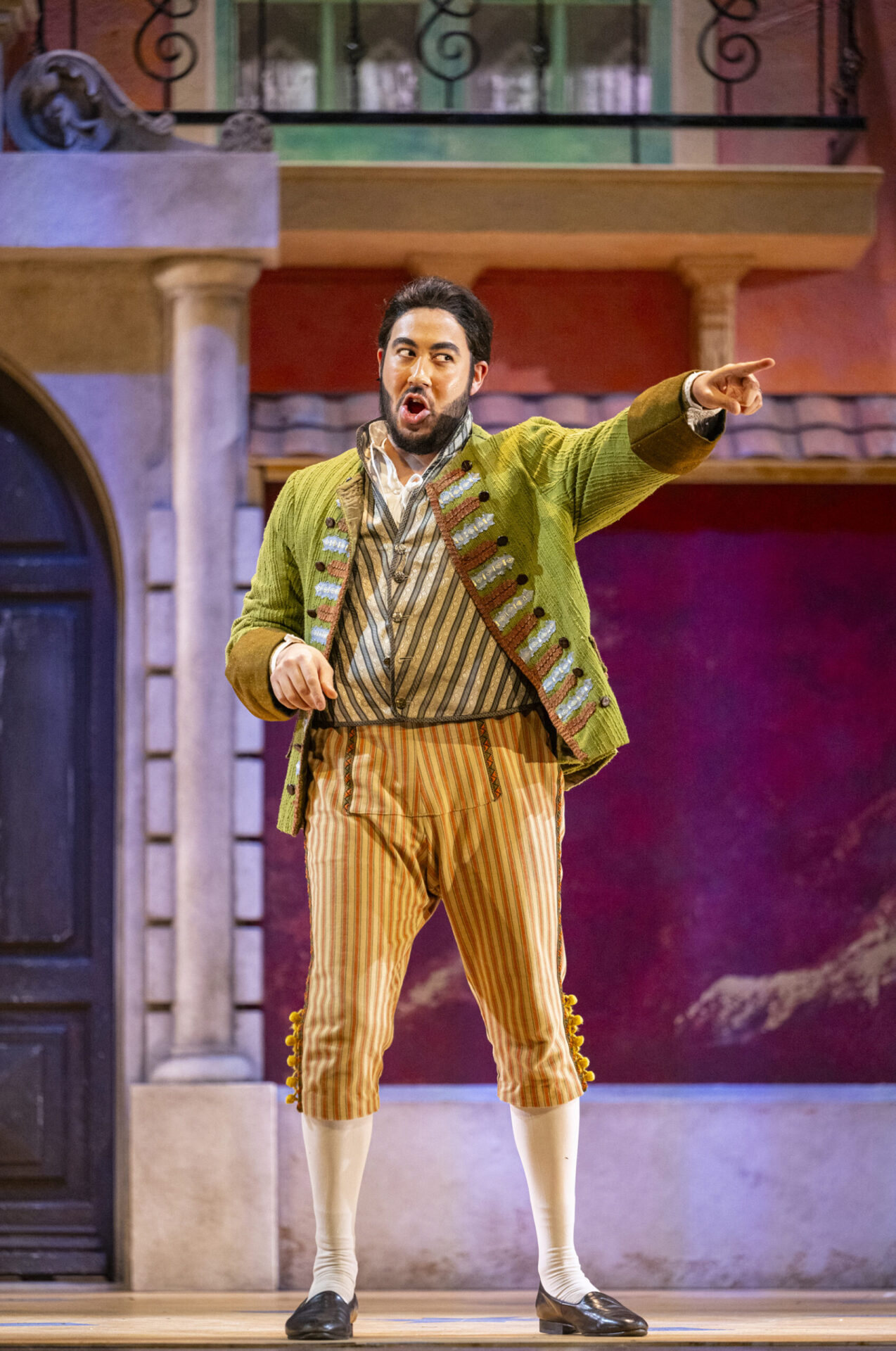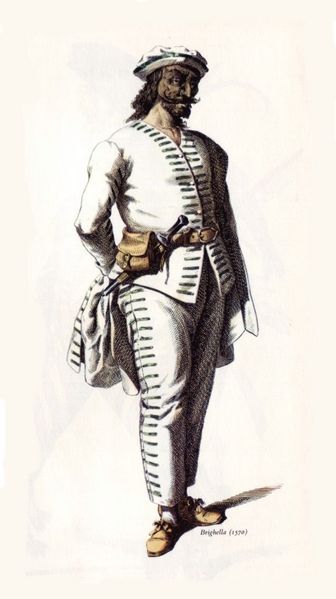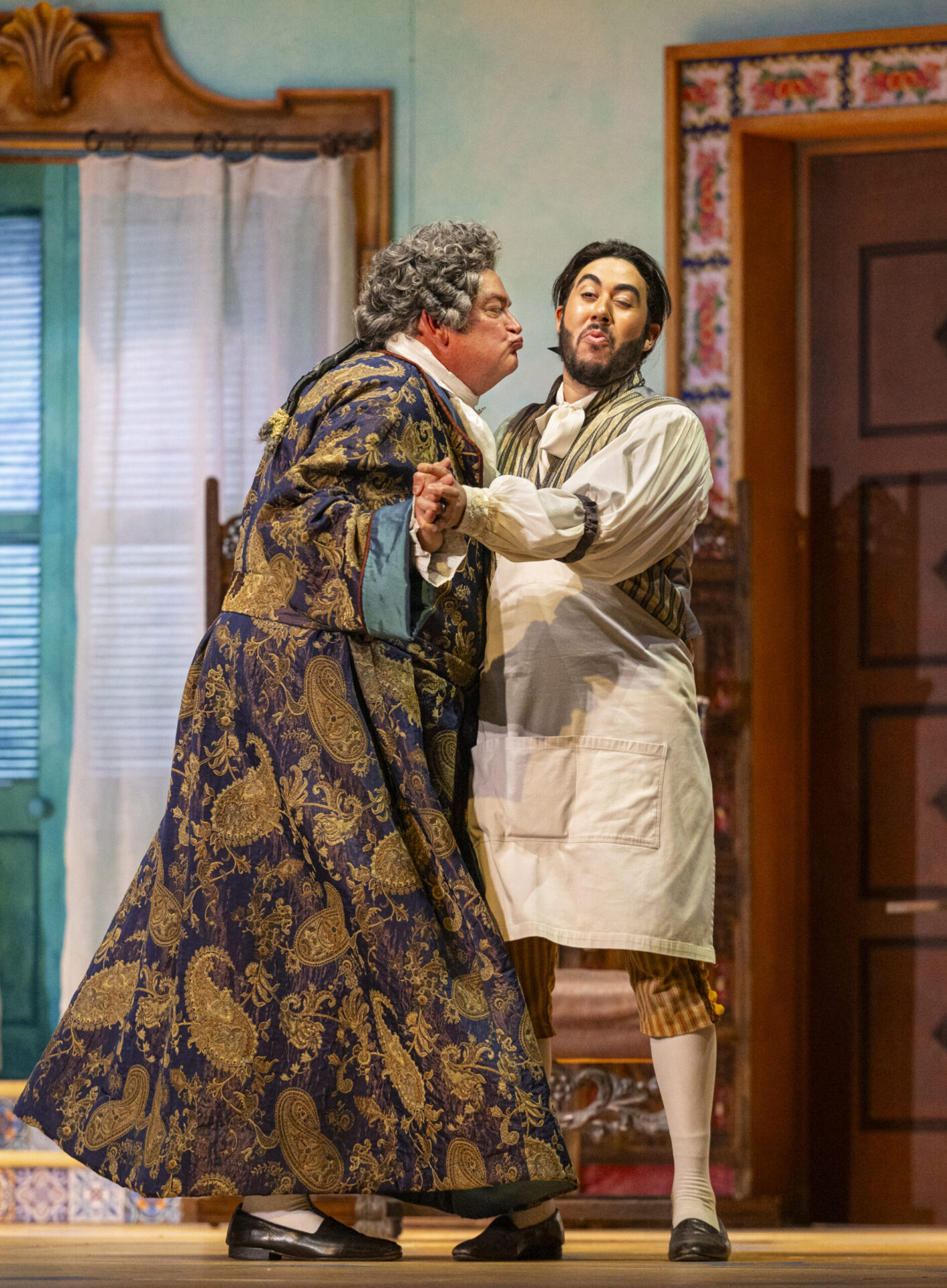Kip Cranna
Dramaturg Emeritus of San Francisco Opera
“Fi-ga-ro! Fi-ga-ro!” That name called out in brilliant baritone braggadocio represents the focal point in some of the most universally recognizable music in the world of opera. It’s so much part popular culture that it’s has been spoofed in Warner Brothers cartoons (warbled by the likes of Tom and Jerry and crooned by Sylvester the Cat.) Robin Wiliams sings it at the beginning of the movie “Mrs. Doubtfire,” and Walter Matthau outwits a border guard by croaking it out in “Hopscotch.”
In its proper context, of course, it’s the splashy entrance song, “Largo al factotum,” delivered by the title character in Rossini’s beloved The Barber of Seville. The scene is a sparkling solo romp full of comic wit and vitality. In his flamboyant self-introduction Figaro indulges in one of opera’s greatest virtuoso ego-trips. As he happily explains, he’s so multi-talented–skilled at everything from shaving beards and trimming wigs to delivering love letters and arranging secret assignations–that he can proudly claim the title “Factotum of the City”—the man who truly “does it all.” He’s so much in demand that everyone calls for him by name. Performing this bravura role requires a lyric baritone with an agile voice and an even more agile acting ability.

Ricardo José Rivera as Figaro
Courtesy of David Allen Photography
But where, we might ask, did this iconic character originate? The idea of a sly guy so richly endowed with ebullient self-confidence must have come from somewhere. And how far has his influence reached into the world of opera, and into Western culture in general?
Let’s start with some basic facts: The character called Figaro, a wily barber later turned valet, was the invention the 18th-century French author born Pierre Augustin Caron (1732-1799), who later gave himself the title “de Beaumarchais.” (He had married a widow who owned some land named “Bois Marchais,” and he liked the sound of that.) The very name “Figaro” is believed by some to be an autobiographical derivative of Fils Caron— “son of Caron.” Figaro became the central character in a trilogy of Beaumarchais’s plays, all dealing with his relationship with the Spanish nobleman Count Almaviva and the Count’s sweetheart, later his wife, Rosina.
Beaumarchais himself was fascinating real-life character, a factotum in his own right, whose occupations included watchmaker, inventor, harp teacher, royal secretary, arms dealer, publisher, and spy. But the pastime that earned him a place in history was as a playwright.
Figaro, like so many figures in Italian comic opera, has his roots in the ancient street theater tradition known as Commedia dell’arte, with its stock characters, standard comic situations, and slapstick sight gags. Among these personalities, the likely progenitor of Figaro is Brighella, a roguish, quick-witted prankster and schemer typically dressed in a distinctive costume of white with green trim. Like his descendant Figaro, Brighella was an opportunistic jack-of-all trades, the personification of cleverness for hire, but nevertheless sentimental when it came to love.

Brighella, by Maurice Sand, 1570.
The first of Beaumarchais’s three French “Figaro plays” was Le Barbier de Seville, ou Le Précaution inutile (The Barber of Seville, or The Useless Precaution), written during the last flourishing days of the French aristocracy, before the revolution began brewing. It was produced by the Comèdie Française in 1775 and was such a big hit that several composers of the day tried their hand at setting it to music. The most successful at first was Giovanni Paisiello, whose opera buffa Il Barbiere di Siviglia (1782) is a pleasantly competent work in the familiar Classic Period style of Haydn and Mozart. Other operatic versions came from the German composers F. L Benda and Johann André (both in 1776) and the French composer Nicolas Isouard (1796). The Italian Francesco Morlacchi created an opera on the story in 1816, and it was in that same year that Rossini trumped them all with his own brilliant musical version, which quickly supplanted all the others.
Whether play or opera, The Barber of Seville is pure comedy in the Commedia dell’Arte tradition. The plot of “Barber” in a nutshell:
The trickster-barber Figaro schemes to help Count Almaviva win the hand of Rosina, outwitting her guardian, old Dr. Bartolo, who wants to marry her himself.
The crotchety Doctor Bartolo is a variation on Pantalone, another stock character from Commedia. The rich elderly man unwisely trying to marry or woo a young girl– and making a fool of himself in the process—is one of the classic schticks in this ancient tradition. The “useless precaution” of the opera’s subtitle refers to Bartolo’s attempt to thwart Rosina’s elopement with the Count by removing the ladder down which the lovers had planned to escape from her balcony. Suddenly finding themselves unable to flee, they take advantage of the notary summoned by Bartolo for his own planned wedding to Rosina, and they quickly tie the knot then and there.
Beaumarchais followed his successful play with a sequel in 1784 in which Figaro is now the Count’s valet at his country estate outside Seville. Entitled La Folle Journée ou le Mariage de Figaro (The Day of Madness, or The Marriage of Figaro), it is characterized by biting political satire, reflecting growing public resentment against the hereditary privileges of the nobility. Performances were banned in Vienna by the Austrian Emperor Joseph II because of the play’s subversive undertones. But one can sometimes get away with singing what is not allowed in speech. The play was transformed into Lorenzo da Ponte’s brilliant libretto for Mozart’s Le Nozze di Figaro, first performed in Vienna in 1786. Mindful of the Emperor’s censors, da Ponte took considerable care to minimize the harsh political tone of the play. Much of Figaro’s verbal defiance of the Count, and in particular his long speech to the audience denouncing hereditary privilege, had to be eliminated. Here’s a bit of Figaro’s inflammatory soliloquy in the play, addressed to the absent Count:
Just because you think you’re a great nobleman, you think you’re a great genius! Nobility, fortune, rank, position—how proud they make a man feel! What have you done to deserve such advantages? You took the trouble to be born. Nothing more. Apart from that, you’re rather an ordinary man.
Though such tirades are missing from Mozart’s opera, “revolutionary” notions can still be detected, as the work celebrates a servant’s open confrontation with a vain and oppressive noble lord. Figaro’s rebellious aria “Se vuol ballare,” for example, has him determined to use his wiles to outwit his master: “If my dear Count wants to dance, I’ll call the tune!”
The plot of The Marriage of Figaro in a nutshell:
Figaro is now the Count’s valet. Figaro’s fiancée Susanna is the Countess Rosina’s maid. The Count is jealous of the pageboy Cherubino’s infatuation with his wife. Figaro and Susanna, along with the Countess, block the philandering Count’s attempts to prevent Figaro’s marriage and to bed Susanna himself.
The third “Figaro” play by Beaumarchais, L’Autre Tartuffe, ou La Mère Coupable (The New Tartuffe, or The Guilty Mother), appeared in 1792, in the midst of the French Revolution. (Tartuffe, a falsely pious charlatan, had been the central character in Molière’s satirical 1664 play of the same name.)
Back-story: Many years have passed. The Count has lost his noble title and fallen on hard times, and he and the Countess and are now living in Paris. Cherubino, the amorous former pageboy turned soldier, had once forced himself on the Countess, who bore his son, Leon. (Cherubino later died in battle.) Meanwhile the Count had fathered an illegitimate daughter, Florestine, who is now his ward. To complicate matters, the Countess’s son Leon and the Count’s daughter Florestine are in love!
The Plot of The Guilty Mother in a Nutshell:
Figaro prevents a scheming, falsely pious Irishman named Begearss (the “New Tartuffe”) from marrying the Count’s daughter Florestine and swindling the Count out of his remaining money. The true parentage of Florestine and the Countess’s son Leon is revealed. Since they are not blood relations, they are free to marry.

Dale Travis as Bartolo and Ricardo José Rivera as Figaro
Photo Courtesy of David Allen Photography
The Guilty Mother was set to music by the French composer Darius Milhaud in 1966, but neither play nor opera could be called a success. The story is tinged with bitterness and cynicism reflecting the aftermath of the Revolution.
The enduring appeal of the Figaro character, however, is proven by the fact that he has cropped up in several operas that were not based on Beaumarchais.
But among all the many “Figaro” operas, Rossini’s The Barber of Seville can still claim top honors for its unforgettable portrait of the trickster haircutter at the center of comic twists and turns on the road to “boy gets girl.” In telling the story in music, Rossini applies his gift for coloratura excess, heightening the wit by having the singers spin off as many notes as they can in the shortest possible time. With a cast of talented artists the results can be electrifying, which is why a comedy like “Barber” will never go out of style.